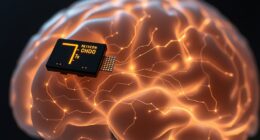Photonic processors are breaking Moore’s Law limits by using light instead of electrons, allowing for faster data processing with less heat and energy loss. They enable high-speed communication and computing at scales where traditional transistors struggle, especially as sizes shrink to nanometers. By harnessing quantum effects like entanglement and integrating quantum photonics on silicon chips, they offer a path to more powerful, efficient systems. To discover how these innovations are transforming technology, keep exploring further details.
Key Takeaways
- Photonic processors use light instead of electrons, enabling faster data transfer and reducing heat, overcoming electronic transistor limitations.
- Integration of quantum phenomena like entanglement enhances processing power beyond classical computational constraints.
- Silicon photonics allows scalable, miniaturized quantum circuits, facilitating practical quantum computing on chips.
- Photonic technology sidesteps physical limits of transistor shrinking, maintaining progress despite Moore’s Law slowing.
- These advancements enable energy-efficient, high-speed systems capable of solving complex problems beyond traditional electronics.

As traditional electronic transistors near their physical limits, photonic processors are emerging as a game-changing technology that could disrupt Moore’s Law. You might already know that Moore’s Law predicts the doubling of transistors on a chip every couple of years, but as transistors shrink to nanometer scales, quantum effects and heat dissipation create insurmountable barriers. That’s where photonics steps in, offering a new way to process information using light instead of electrons. Photonic processors leverage silicon photonics, a technology that integrates optical components onto silicon chips, enabling high-speed data transfer with minimal energy loss. This shift from electrical to optical signals not only increases processing speed but also dramatically reduces heat generation, opening doors to faster, more efficient computing.
One of the most fascinating aspects of photonic processing is its ability to harness quantum phenomena like quantum entanglement. Unlike classical bits, which are either 0 or 1, quantum bits or qubits can exist in multiple states simultaneously, thanks to superposition. When entangled, qubits become interconnected such that the state of one instantly influences the state of another, regardless of distance. This property could revolutionize how you perform complex computations, enabling quantum-enhanced algorithms that surpass classical capabilities. In the context of silicon photonics, researchers are developing systems where entangled photons are generated and manipulated on integrated chips, paving the way for practical quantum communication and computation. These advancements could lead to processors capable of solving problems that are currently intractable, such as simulating molecular interactions for drug discovery or optimizing large-scale logistical systems.
You should also consider that integrating quantum entanglement with silicon photonics offers scalability and stability advantages. Silicon, being a well-understood and mature material, provides a robust platform for producing scalable, miniaturized quantum photonic circuits. This integration means you could soon see chips that combine classical and quantum functionalities, vastly expanding computational power without the exponential increase in size or energy consumption that traditional architectures require. Such developments are critical for breaking through the physical barriers that have long constrained Moore’s Law. As you watch these technologies evolve, you’ll notice that photonic processors are not just incremental improvements but potential game-changers that could redefine computing’s future. They promise faster, more powerful, and more energy-efficient systems, fundamentally altering what’s possible in information processing. Understanding these advancements in photonics highlights how innovative material and quantum integration are pushing the boundaries of current technology.
Frequently Asked Questions
How Do Photonic Processors Compare in Energy Efficiency to Electronic Processors?
You’ll find that photonic processors are more energy-efficient than electronic ones because they use optical power to transmit data with less heat and power loss. This means they require less energy to operate, especially at high speeds and over longer distances. By leveraging light instead of electricity, you can achieve faster processing with lower energy consumption, making photonic processors a promising solution for reducing overall energy use in computing systems.
What Are the Main Challenges in Mass Manufacturing Photonic Processors?
When mass manufacturing photonic processors, you face challenges like fabrication scalability and material compatibility. Scaling up production requires precise, consistent fabrication techniques, which can be difficult given the complex nanostructures involved. Additionally, ensuring that materials used in photonics are compatible with existing semiconductor processes is essential. Overcoming these hurdles involves developing new manufacturing methods and finding materials that integrate smoothly with current technologies, making widespread adoption more feasible.
Can Photonic Processors Integrate With Existing Semiconductor Technology?
You can integrate photonic processors with existing semiconductor technology, but silicon integration presents fabrication challenges. These challenges include aligning optical components with electronic circuits precisely and maintaining compatibility with current manufacturing processes. Overcoming these hurdles requires innovative fabrication techniques and design adjustments, making seamless integration possible. As a result, hybrid systems combining photonics and electronics are advancing, offering faster data processing without overhauling established semiconductor infrastructures.
How Do Photonic Processors Impact Data Security and Encryption?
While photonic processors boost speed and efficiency, they also reshape data security and encryption. You might think faster processing means heightened risks, but they actually enhance quantum encryption, making data breaches harder. By leveraging light-based technology, they help maintain data integrity and protect sensitive information. However, as they evolve, you’ll need to stay vigilant about new vulnerabilities, ensuring encryption keeps pace with their rapid advancements.
What Industries Will Benefit Most From Photonic Processor Adoption?
You’ll find industries like quantum computing and space exploration benefit most from photonic processor adoption. These processors enhance data processing speeds and efficiency, making complex calculations faster and more reliable. In quantum computing, they help handle massive data sets, while in space exploration, they enable real-time data analysis from distant satellites. This leap in technology accelerates innovation, opening new frontiers for research and applications you might not have imagined before.
Conclusion
Just like a rocket soaring past barriers, photonic processors are breaking through Moore’s Law limits, opening new frontiers in computing power. Instead of slowing down, they accelerate innovation with light-speed efficiency, transforming how we process information. As you witness this technological leap, remember that these advancements are not just incremental; they’re a revolution, shining brighter and faster than ever before—like a star blazing through the night sky. The future of tech is truly glowing brighter.
Ava combines her extensive experience in the press industry with a profound understanding of artificial intelligence to deliver news stories that are not only timely but also deeply informed by the technological undercurrents shaping our world. Her keen eye for the societal impacts of AI innovations enables Press Report to provide nuanced coverage of technology-related developments, highlighting their broader implications for readers.










